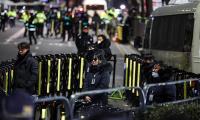Punjab is a crucial battleground in the 2024 general elections. Out of 266 National Assembly seats, 141 general seats and 35 reserved seats for women are in this province.
So in a House of 336, Punjab will send 176 members to the National Assembly. These seats are crucial to form the government in Islamabad.
In a functional, strong and well-established democracy, it is the voters who decide the fate of political leaders and parties, but, unfortunately, we are not lucky enough to decide our own destination and future. Hence, it will be the powers that be and a handful of feudal, capitalist and influential electables who will decide the outcome of the next elections.
The party that embraces the maximum number of electables is likely to win most seats in Punjab. Political parties play a key role in elections on nearly 40 urban constituencies, but not on the remaining 101 rural constituencies. The real battle in Punjab is expected between the PML-N and the PTI.
This time the PML-N has a combination of these factors. First, it has the ‘blessings’ of the powerful quarters. It has the maximum number of electables and strong candidates with money, influence, votes and the right connections. So the PML-N has the edge in this election in Punjab.
The PTI was ahead in the popular vote before the May 9 events. However, post the incident, many electables quit the PTI. And while previously a close contest was expected between the PML-N and the PTI, the crackdown against the PTI and the return of former prime minister Nawaz Sharif from London in October have changed the situation.
Even after the May 9 events, most opinion polls indicated that the PTI was still the most popular political party in Punjab. But Nawaz Sharif’s return has changed the equation and rescued the drowning ship of the PML-N.
In my article titled ‘The Nawaz factor’ published in these pages on October 24, 2023, I said: “Many political commentators and analysts had dismissed the Nawaz factor. For them, Nawaz Sharif was no longer a crucial factor in the revival of the PML-N’s popularity. They were of the view that Nawaz was disconnected from the ground realities of Pakistan, so in the current circumstances, he might not be able to make a huge impact.
“But Nawaz Sharif once again proved that he is still the main crowd-puller for the PML-N. The Lahore power show proves that they are still willing to give another chance to Nawaz Sharif despite having some doubts or questions. The PML-N has revived its political fortunes under his leadership.”
It seems the PML-N has gained the upper hand in Punjab and is likely to emerge as the largest party in the elections, form the next government in Punjab, and win a simple majority in the Punjab Assembly. Recent opinion polls clearly indicate that the PML-N is the most popular party in Punjab. According to the IPOR survey, the PML-N’s popularity stands at 45 per cent while the PTI’s stands at 35 per cent. According to a recent Gallup Pakistan survey, Nawaz Sharif has become the most popular leader in Punjab after dethroning Imran Khan.
The Supreme Court’s decision to withhold the PTI’s election symbol ‘bat’ for not organizing proper intraparty elections was a big blow for PTI candidates who are now contesting as independent candidates with different symbols. They are also facing problems while running their campaigns in several constituencies.
It seems that the PTI has made mistakes in selecting candidates and chosen weak candidates against strong PML-N contenders. A lot has changed over the last few years. More than 60 per cent of the PTI’s MNAs elected in the 2018 elections have left the party. They are either contesting on PML-N tickets or as independents. Even though in some constituencies the PTI still has strong candidates capable of winning their seats, their number is limited.
The other problem the PTI faces in the election campaign is its weak or rather non-existent party organization. PTI’s organisational structure was weak even before the May 9 events and the subsequent crackdown. Now the party’s structure is in tatters. PTI candidates mainly rely on social media for their campaigns. But it needs polling agents and activists to manage polling stations on Election Day. This cannot be done through social media. The PML-N is taking full advantage of the situation and trying to win maximum seats from Punjab.
My research says that the PML-N is likely to take 90-95 National Assembly seats from Punjab. In northern Punjab, the PML-N is likely to take seven out of 13 National Assembly seats. Independents including Ch Nisar Ali Khan are likely to win four seats while the PPP and the IPP are expected to win one seat each.
In central Punjab, there are 80 National Assembly seats, and the PML-N is likely to win around 60 seats. Independents are likely to win 15 seats. The IPP with help from the PML-N is expected to win four seats while the PPP is likely to win one seat from central Punjab. The PML-N even dominated central Punjab in the 2018 elections when it faced a lot of odds. The PML-N is likely to sweep Sialkot, Narowal, Gujranwala, Lahore, Kasur, Sargodha, Toba Tek Singh, Okara and Sahiwal districts as it did in 2018.
In 48 seats of south Punjab, the PML-N is likely to win around 27 and take a majority of seats from Khanewal, Multan, Vehari, Bahawalnagar, Bahawalpur, Rahim Yar Khan, Rajanpur and DG Khan districts. The PPP is likely to win 9-10 seats. Independents are likely to win nine seats, and the IPP and the PML-Q may win one seat each.
The PML-N may not be able to repeat what it did in the 2013 elections when it succeeded in winning 116 out of 148 seats. It won 216 seats in the Punjab Assembly. In 2013, the party won most of the urban seats and continued to maintain its dominance in central, south and northern Punjab.
This time as well, in the Punjab Assembly, the PML-N is likely to win a simple majority and will form the government in Punjab.
The writer is a freelance journalist.
On December 21, Trump unleashed fresh salvo, lambasting Panama for its "unfair" canal fees
According to Unicef, estimated 22.8 million children aged 5 to 16 are out of school in Pakistan
Urdu slogan carrying incumbent PM’s name is ‘Shehbaz Karey Parwaz’, which means Shehbaz is high flier
Gender disparities are pronounced in KP, where girls account for 64% of OOSC
Chinese philosopher Mencius prophesized 3000 years ago that state that does not employ worthy perishes
Over past two decades, rapid and often chaotic development has increasingly defined Islamabad's landscape







